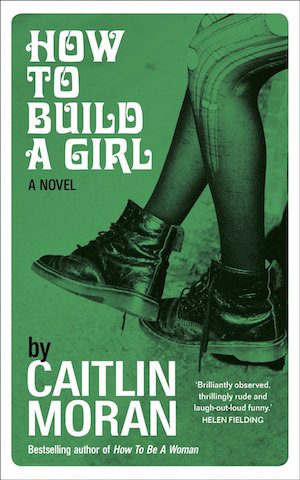Caitlin Moran chats with the Rumpus Book Club about how Wolverhampton has changed over the years, the forthcoming film version of her new novel How to Build a Girl, chapatis, and how Blur hogs the pool table.
This is an edited transcript of the book club discussion. Every month The Rumpus Book Club hosts a discussion online with the book club members and the author, and we post an edited version online as an interview. To learn how you can become a member of the Rumpus Book Club, click here.
This Rumpus Book Club interview was edited by Brian Spears.
***
Amanda: Hi Caitlin. Nice to ‘meet you.’ I really enjoyed diving into Johanna’s world… I love the honest way you write.
Caitlin Moran: HELLO Amanda!! That’s very lovely of you! Honesty is my favourite thing in writing. When you write something and someone else goes “Yes! That’s how I feel! That’s what I think! It’s like you’re in my head!”
Brian S: So do you have a playlist for this novel? Or alternately, what are you listening to lately?
Caitlin Moran: When I write, I listen to the same things over and over again. I caned the Daft Punk album—particularly “Lose Yourself To Dance,” and I always cried on the line “I know you don’t get a break that often” because I was so tired, because the deadline was so tight. I would prop up a mirror and watch myself crying, thinking “You are a brave crying author.” Then I would pull myself together by listening to “Rebel Rebel” by David Bowie, which is always the equivalent of doing two shots of vodka. Instant bracer. Bowie always sorts everything out.
Amanda: Was it hard to get back into a teenagers head? You definitely captured those mixed emotions of being a teenager—naive yet overly confident, etc. I found myself thinking yes! I remember feeling that way. But I doubt I could have sat down and put myself back in that mind frame.
Brian S: I loved the honesty in the voice as well, the uncertainty of being a teenager (which I still remember even though it was long long ago—I’m about seven years older than Johanna/Dolly)
Ben: Hi Caitlin: I enjoyed the book: witty and quick-witted young woman! I don’t know the music of the 90s very well, but I know a little about England and the Midlands.
Caitlin Moran: Amanda if you could see me now, you’d see I was dressed in exactly the same way as I was when I was 16. Doc Martens, black opaque tights, shorts, t-shirt, back-combed hair, cheap Rimmel eyeliner. I’m still very in touch with my inner teen. And my adolescence seemed super-vivid because between 11-16 my parents didn’t really let us have people over to our house, and we were taught at home, and we never really went anywhere, so when I started going out, and getting kissed, and going to gigs, it all seemed explosively exciting. I remember every tiny atomic second of it.
Brian S: How long did it take to put this book together?
Ann: Did you meet any/most of the referenced bands when you were a music journalist?
Caitlin Moran: Bands that I met—yeah, most of them, I guess. Manic Street Preachers, Suede, Courtney Love, Pixies, Ride, Blur, Teenage Fanclub, PJ Harvey, Beastie Boys. I started as rock critic at The Times when I was 17, so I could interview whoever I liked. It was fucking awesome. The Courtney Love interview lasted sixteen hours—we gate-crashed a party together, we went to a diner and got into an argument with a redneck, we went back to the hotel and she told me about hte first time she and Kurt fucked, him taking Ecstacy, promised to hook me up with their nanny—in those days you got to hang out with bands for days. and the British bands all hung out in the same small dirty old man’s pub, The Mixer, in Camden, so you’d see them every day. You’d be like “God, WHEN will Blur get off the pool table? Tsk.”
Brian S: Have the Midlands changed much since your childhood?
Caitlin Moran: I was amazed how Wolverhampton had changed when I went back there recently. It was SO poor and depressed then. I went back with my siblings recently—our favourite nightclub was closing down, so we wanted one last mosh to “Jump Around” by House of Pain—and our local pub, which used to be a Hell’s Angels pub, was selling CHAMPAGNE and OYSTERS. I couldn’t fucking believe it. Oysters in Wolvo. In my day, the poshest thing you could get was a prawn and mayonnaise sandwich from Marks & Spencers.
Andrea: Would you recommend the fake-it-until-you-make-it strategy now?
Ann: I read a blog today that claimed that ‘fake-it-till-you-make-it’ is another way of saying ‘practice.’ Seems about right for Johanna/Dolly. She was practicing for being a woman. I wonder about Johanna’s wall of words. Is that inspired by a real-life habit?
Caitlin Moran: Ann—yes! I had that wall! Huge poster of Courtney Love, pages from On the Road and Alice in Wonderland, pictures of Elizabeth Taylor and David Bowie. All teenagers do, don’t they? That’s where we put all the things we love, or want to become.
Brian S: I had my favorite poems carefully written on the covers of my notebooks for school. No room for posters in my tiny room.
Ben: I went to a boarding school 1961-65—no posters, no record players allowed, no radios either—had to catch the 60s on the sly until college.
Brian S: My version of the late night DJ playing music on the radio no one else was was a guy named Coyote J Calhoun, and it was once a week, on Sunday nights. But that’s the only place I could hear the Violent Femmes and Robyn Hitchcock and the Egyptians and Siouxsie Sioux and Black Flag and so on. But that’s such a brilliant and romantic way to discover music. Wouldn’t trade it for anything.
Caitlin Moran: Hahaha, oh Black Flag—when Rollins went solo, it was his song “There’s A Man Outside” that was the first “alternative” song I ever heard, the first time I listened to John Peel, and it totally shat me up. To my tender ears, raised on The Beatles, sounded EVIL. I put that in the book. This is it:
Ann: Do you still eat chapatis? Mmmm, chapatis.
Caitlin Moran: Ann, I have adopted many of the wanky traits of the London middle classes now, and eschew most carbohydrates in favour of extremely expensive kale snacks. Unless I’m hungover, in which case, everything goes.
Brian S: I never figured you for a kale person. My favorite factoid about kale is that Pizza Hut buys about 90% of the kale grown in US. They use it to decorate their salad bars.
Ann: Do you imagine Johanna might be a lot like you at this age? Or do you envision her veering a different direction? I’m hogging the questions. I’ll shut up and eat a sausage roll after this.
Andrea: Since it made me giggle to imagine Picard’s reaction, I have to ask. Did you send Patrick Stewart a copy of the book?
Caitlin Moran: Ann—”How To Build A Girl” is the first in a trilogy. The second book is called “How To Be Famous,” and takes up six months after this. and then the third is called “How To Change The World,”where she and John Kite are in their late thirties, and they’re trying to change the political landscape of the country. So hahaha I guess she does kind of end up like me, but more driven and successful and revolutionary.
Brian S: Oh excellent! How far along are those books?
Caitlin Moran: They’re a collection of coloured post-it notes on the wall at the moment. We’ve got to write the screenplay for “How To Build A Girl” first—it’s going to be a film! Hurrah!
 Brian S: Nice! What sort of details can you give us about that?
Brian S: Nice! What sort of details can you give us about that?
(Like actors tied to the project, director, that sort of thing)
I guess what I’m really asking is, who’s playing Dolly?
Michelle: Are you writing the screenplay or consulting with someone else who is? I imagine that type of translation would be very different from a novel
Caitlin Moran: It’s with the same people who made 12 Years A Slave, Les Miserables, Bridget Jones and Pride & Prejudice, and the casting’s going to be FUN. I did an event in NYC last night, and met an actress who might be Johanna… it’s early days, but she was a really exciting girl. Like a young Jennifer Lawrence. OH GOD IT’S ALL THRLLING.
I’m co-writing with my friend and hero John Niven, who wrote the cult novel Kill Your Friends. He’s a filthy Scottish cigar-smoking man around town and we’re working on another film together too, set in the 16th century, and based on the life of a 20-year-old bisexual opera star and swordswoman called Julie d’Aubigny. She was a REAL woman, and her story is incredible.
Brian S: That sounds like an amazing story.
I want to say, I especially appreciated the bit where Dolly comes to realize that there’s only so far you can go with cutting people in reviews. We have similar arguments about the value of negative reviews in poetry.
About the reviews: I’m not opposed to a negative review if there’s a solid reason for it, but more often they just come off as one person slagging another because it’s easy to do. Like Dolly says, it’s hard to be a fan and say why you adore something.
Caitlin Moran: Awww thank you Brian—I basically believe in celebrating what you love, and just ignoring the things you don’t like. When I was a TV critic, I would just keep watching shows until I could find ones I loved and could enthuse about, rather than just watching the week’s biggest shows and slagging them off if I didn’t like them. I think it takes more skill to write positively about something, whilst still remaining interesting and amusing. You just have to make more of an effort than when you make a load of bitchy jokes about something.
Brian S: Exactly. Ignore what doesn’t speak to you in some way. I’ve almost gotten to the point where I’m unwilling to say I think something is bad. “It doesn’t work for me” is about as far as I’ll go, most of the time. Except for Air Supply. They’re fucking terrible.
Caitlin Moran: You see, I can always make an exception to the “don’t slag something off” thing if it’s a TV show that involves Simon Cowell.
Brian S: That’s completely valid.
Thanks for joining us tonight, Caitlin. Best of luck with the book and the film(s). Really looking forward to the sequels, and visiting with Dolly some more.




